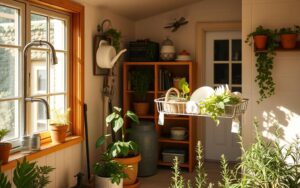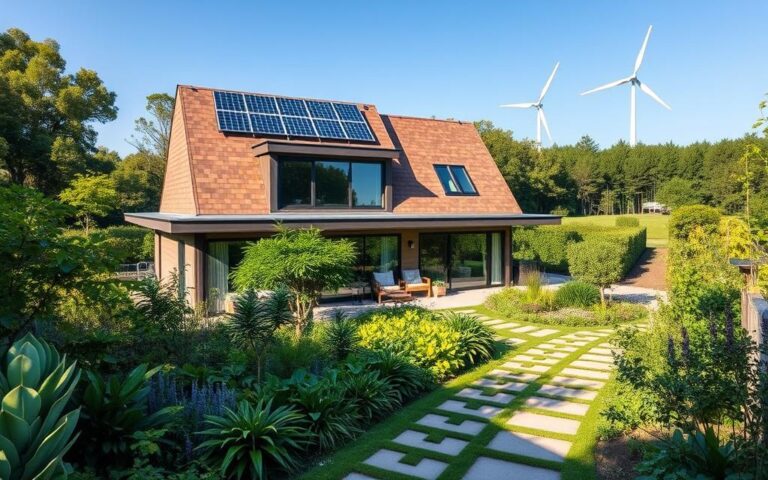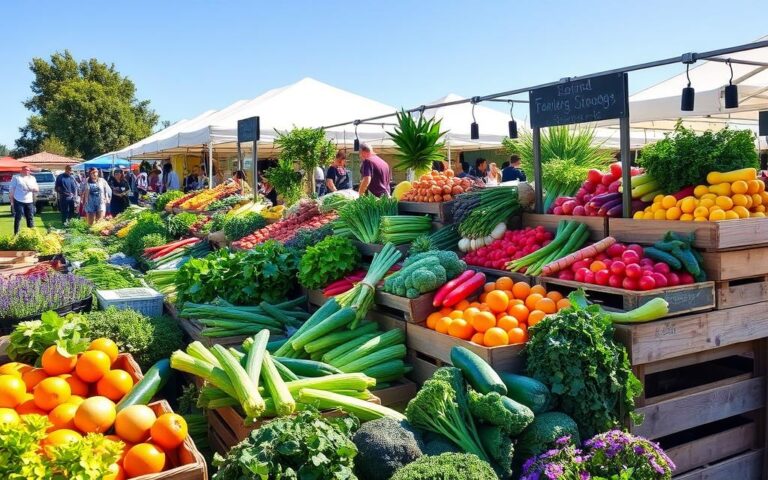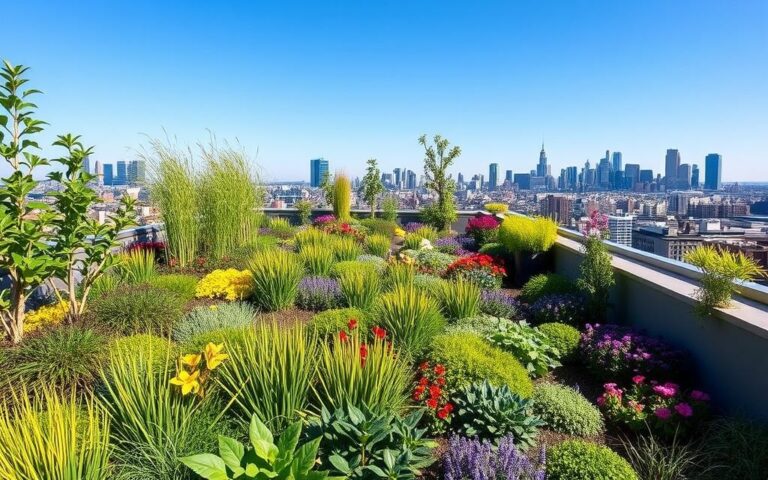Our planet faces growing water scarcity. This makes reducing home water use more important than ever. With more people and worsening climate change, sustainable practices are key. Even small steps by individuals can lead to big changes. When you save water, you protect the environment. You also fight the problems from using too much water. The United States Environmental Protection Agency (EPA) supports this with different projects. They show how each person’s efforts are important for water sustainability.

The Importance of Water Conservation
Water is a critical resource that we must protect to keep life going on Earth. Over two billion people now face water shortages in their countries. These facts show how crucial it is for us to save water. By saving water at home, we can make a big difference. It’s good for our planet, our community’s economy, and the environment.
When we use less water, we also spend less money. Lower water bills mean we have more money for other things. Plus, using less hot water cuts down on energy costs. So, by saving water, we lower our living expenses.
Water conservation also helps wildlife and the places they live. Freshwater environments are home to many different animals and plants. Using less water means these places are healthier. This supports more life and cleans the water in our rivers, streams, and wetlands.
Every community can play a part in saving water. By learning how to waste less water, we support a culture of saving. This approach is beneficial for all of us, promoting a better future.
| Benefit of Water Conservation | Impact |
|---|---|
| Lower Water Bills | Decreased monthly expenses on utilities |
| Reduced Energy Costs | Less energy used for heating water |
| Environmental Preservation | Healthier ecosystems and improved biodiversity |
| Community Awareness | Encourages sustainable practices among neighbors |
Simple Changes to Reduce Water Usage
Making small daily routine changes can greatly improve water use efficiency at home. These adjustments not only reduce water use but also encourage green water habits. Everyone can play a part in this.
- Fixing Leaks: Quickly fixing leaks in taps and toilets is a smart move. Just one dripping tap can waste lots of water every day.
- Turn Off Taps: Always turn off the tap when brushing teeth or shaving. This easy step can save a lot of water daily.
- Limit Shower Times: Keep showers under five minutes to save water. Using a timer can help you stay on track.
- Use Full Loads: Only use the dishwasher and washing machine when they’re full. This makes every use more efficient and limits water waste.
- Install Aerators: Adding aerators to faucets cuts down water flow but keeps pressure up. This change saves a lot of water in kitchens and bathrooms.
WaterSense says adopting even some of these green habits can hugely reduce home water use. These easy changes promote a sustainable way of living and protect our valuable water resources.
| Change | Water Saved per Year |
|---|---|
| Fixing Leaks | About 10,000 gallons |
| Turning Off Taps | About 200 gallons |
| Limiting Shower Times | About 1,000 gallons |
| Using Full Loads | About 3,000 gallons |
| Installing Aerators | About 500 gallons |
By making these smart adjustments, we’re all moving towards a more water-efficient lifestyle. It’s a big win for the environment and our own efforts to conserve.
Reduce Water Usage in the Bathroom
The bathroom is a key area for saving water at home. Simple changes can greatly reduce water use and cut down on bills.
Think about getting low-flow showerheads and toilets. These use much less water than normal ones, saving over 40% of water. Water-efficient faucets also help by providing enough water without waste.
Being mindful when bathing helps too. Try to shower for less time or use less water in baths. Turn the tap off while brushing or shaving. This can save lots of water daily.
The EPA’s WaterSense program has great tips for saving water. They list products and ways to be more water-efficient, helping you choose wisely.
| Water-Saving Technique | Estimated Water Savings |
|---|---|
| Low-flow showerheads | Up to 40% reduction |
| Water-efficient toilets | 1.6 gallons per flush |
| Flow-restricted faucets | Over 30% reduction |
| Mindful bathing routines | Several gallons per session |
Using these strategies really helps in saving water at home. Every small change adds up, showing that we all have a part in sustainability.
Water-Saving Techniques for the Kitchen
The kitchen is a key place where a lot of water is used. By applying smart water-saving strategies, we can cut down on how much water we use. Studies show that dishwashers can save more water than washing dishes by hand, if fully loaded. They need less water per wash compared to keeping the tap on when hand-washing.
Try these simple tips to use less water in your kitchen:
- Fill a bowl with water to wash fruits and vegetables instead of letting the tap run.
- Only run the dishwasher when it is at full capacity.
- Use a basin to catch the water while rinsing dishes, then reuse that water for plants.
- Regularly check for leaks in taps and pipes to prevent water waste.
The American Water Works Association says that families can save about 1,200 gallons of water a year with these changes. Taking up these habits is important for reducing wasted water and keeping our daily routines eco-friendly.
| Technique | Estimated Water Savings |
|---|---|
| Using dishwasher | Up to 5,000 gallons/year |
| Washing veggies in a bowl | Up to 1,000 gallons/year |
| Reusing rinse water | Approximately 500 gallons/year |
| Fixing leaks | Up to 10,000 gallons/year |
By putting these practices into action, we all can make a big difference in saving water at home. This helps in highlighting the need for being mindful of how much water we use in the kitchen.
Reducing Water Usage Outdoors
Outdoor water use is a big part of a home’s overall water use, especially when it gets warm. To cut down water use outside, we can use smart methods. This not only helps our planet but also supports living in a way that’s good for the future. By using water wisely outdoors, people can help save our precious resources.

- Xeriscaping: This is about choosing plants that don’t need much water. This can greatly cut down on water use.
- Drought-resistant plants: Using local plants that are used to the climate reduces the need for extra watering.
- Rain barrels: Collecting rainwater gives you a cost-free water source for your plants and lawn. It’s a smart water choice.
Knowing when and how to water is key to use less water and keep plants healthy. Watering in the early morning is a good strategy. Plants get enough time to drink up the water before the sun gets too hot.
| Watering Time | Benefits |
|---|---|
| Early Morning | Reduces evaporation, promotes healthy root development |
| Midday | Leads to higher evaporation rates, wasteful |
| Evening | Can cause fungal growth, less efficient than morning |
Getting involved in local conservation projects can make a big difference in saving water outdoors. Local garden centers often offer tips and classes on how to garden in a way that’s good for the earth. By choosing wisely, we can all play a part in using less water outside.
Incorporating Sustainable Water Practices in Daily Life
Adding sustainable water habits into our everyday life brings benefits for us and our communities. Making small changes helps the environment. By adopting eco-friendly water behaviors, we make a big difference.
Being involved in the community is key. Joining local groups that protect water teaches us a lot. These efforts raise awareness and motivate others to save water too.
It’s helpful to keep track of how much water we use. Writing it down or using apps can show where we can use less. Spotting these habits is the first step to being more eco-conscious.
Learning about our local water ecosystems is eye-opening. Educational programs show how our choices affect our rivers and lakes. This understanding encourages us all to care more for our water sources.
Using Technology to Save Water at Home
New tech helps us use less water at home. Smart irrigation systems and water-saving appliances are key. They make it easy to keep track of and manage how much water we use.
With smart irrigation, your garden gets just the right amount of water. This stops wasting water and keeps your garden healthy. It’s a big step towards using less water outside.
Water-efficient appliances like certain dishwashers and washing machines save a lot of water. They work just as well without using as much. Experts say it’s smart to switch to these models to save water at home.
IoT devices are changing the game in saving water. They connect to your phone and tell you about leaks fast. This lets you fix leaks right away and stops water waste.
| Technology | Benefits | Example Brands |
|---|---|---|
| Smart Irrigation Systems | Optimizes watering schedules; minimizes waste. | Rachio, RainMachine |
| Water-Efficient Appliances | Reduces water and energy consumption. | Whirlpool, Bosch |
| IoT Leak Detection Devices | Detect leakages promptly; alerts homeowners. | Flo by Moen, Aqara |
Using these technologies shows we care about the planet. Homes with these tools use much less water. They help us live in a way that’s better for the earth.
Educational Resources and Community Initiatives
Educational resources are key in promoting water conservation. They focus on making people aware. Local groups and governments work together. They provide workshops, brochures, and tools. These are for teaching sustainable water use.
Many places have programs for public education on saving water. For example:
- Local workshops on rainwater harvesting.
- Brochures about plants that need less water.
- Webinars on using less water at home.
There are a lot of websites that help with education. They have guides and support for joining community projects. State programs also help teach about water conservation’s importance.
This work helps communities care more about saving water. By taking part in water initiatives, more people learn to conserve. This is important for everyone.
How to Measure and Monitor Water Consumption
Knowing how to track water usage is key for homeowners looking to save water. By monitoring how much water you use, you can find ways to cut back and be more aware of your consumption.
Start by looking at your monthly utility bills for water use patterns. Keeping an eye on your water use over months helps you see changes and understand when you use more water.
A water meter can accurately measure how much water you use. Most homes have one. If yours doesn’t, think about getting one to better monitor your usage.
To dive deeper, figure out water use per person in your home. Just divide your total monthly water use by the number of people living there. This shows everyone’s water use habits.
See a sudden rise in your water use? Look into it fast. This could be due to leaks in faucets, toilets, or hoses. A plumber can fix these leaks, stopping the waste.
Your local water authority may offer help to track and reduce water use. Use their tools and advice to make a plan that works for your home.
Conclusion
Reducing water use at home is now more important than ever. Adopting sustainable practices helps our environment. Fixing leaks and using water wisely can greatly lower water use over time.
By following the advice shared, people can save water and encourage others to do the same. We all have a part in building a culture that values saving water. This helps ensure that clean water will be available for all in the future.
It’s time to act and change our daily habits. Start using these water-saving tips now. Together, we can help save our planet and secure water for ourselves.
FAQ
What are some effective water conservation tips to implement at home?
You can save water by immediately fixing any leaks. Install fixtures that use less water. Also, get into the habit of turning off the water when you’re brushing your teeth. These simple actions make a big difference in cutting down your water usage.
How can I reduce water waste in my bathroom?
To cut down on water waste in your bathroom, consider installing water-saving faucets and showerheads. Try taking shorter showers. Make sure to only flush the toilet when there’s a full load. These actions help conserve water.
What changes can I make in the kitchen to save water at home?
You can save water in the kitchen by using a dishwasher and making sure it’s full before running it. Instead of running tap water, rinse your veggies in a bowl. These steps lead to more efficient water use at home.
How can smart technology help in reducing water usage?
Smart technology, like efficient irrigation systems and appliances, helps keep an eye on water use. These smart devices support sustainable living by helping you track and reduce daily water consumption. Plus, they’re great for spotting areas where you can improve.
What are some water-saving techniques for outdoor use?
For saving water outdoors, try xeriscaping with plants that need less water. Collect rainwater and water your plants early in the morning to minimize evaporation. These methods greatly decrease your outdoor water use.
How can I measure my household’s water usage effectively?
Check your water meter often and look over your utility bills each month. You might also track how much water you use daily using apps or a journal. Spotting sudden increases helps you find leaks or areas to be more efficient.
What resources are available for learning about sustainable water practices?
There are many resources for learning about water saving. Look into local environmental groups, conservation websites, and community programs. They often offer workshops and materials to help you learn more about conserving water.




